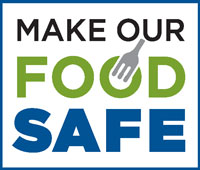Multistate Foodborne Outbreaks: A Timeline
Significant Outbreaks Since Passage of 2011 Food Safety Modernization Act
 In January 2011, President Obama signed the FDA Food Safety Modernization Act (FSMA) into law, signaling the first major update to our nation's food safety framework since the Great Depression. Despite bipartisan support, and a coalition of food safety advocates and industry representatives working for its enactment, the administration still has not issued the proposed rules needed to begin implementing this law. This interactive graphic represents ten widespread multistate foodborne illness outbreaks linked to FDA-regulated products since FSMA was enacted, which constitute a small fraction of total foodborne illnesses reported during that period. Click on the arrows or select a date to learn more.
In January 2011, President Obama signed the FDA Food Safety Modernization Act (FSMA) into law, signaling the first major update to our nation's food safety framework since the Great Depression. Despite bipartisan support, and a coalition of food safety advocates and industry representatives working for its enactment, the administration still has not issued the proposed rules needed to begin implementing this law. This interactive graphic represents ten widespread multistate foodborne illness outbreaks linked to FDA-regulated products since FSMA was enacted, which constitute a small fraction of total foodborne illnesses reported during that period. Click on the arrows or select a date to learn more.
The U.S. Centers for Disease Control and Prevention estimates that one in six Americans (48 million people) suffer from a foodborne illness each year, resulting in 128,000 hospitalizations and 3,000 deaths.
What defines an outbreak?
- An outbreak is defined as an incident in which two or more persons experience a similar illness resulting from the ingestion of a common food.
- Sporadic cases, illnesses that are not part of an outbreak, make up the overwhelming majority of foodborne illnesses reported annually.
- A number of events must occur for an illness to be appropriately diagnosed and reported: a sample must be submitted for testing, the test must identify the pathogen, and the illness must be reported to state public health authorities. In order to accurately estimate the number of illnesses caused by pathogens, CDC determines the number of confirmed illnesses and adjusted for underdiagnosis and, if necessary, for underreporting by using a series of component multipliers.






